Redstone has been forever changed with the addition of a wireless component in the previous Minecraft 1.19 Wild Update, one of the sculk family blocks – sculk sensor. This block has made redstone engineering so much easier and more compact. Furthermore, many players who haven’t played with redstone all that much experienced and experimented with this rather fun block, due to all the silly opportunities they had in pranking their server mates. In this guide, however, we are going to cover a block introduced in the Minecraft 1.20 Trails and Tales update. It is going to help Minecraft players even more in their redstone adventures – Calibrated Sculk Sensor.
What is the Calibrated Sculk Sensor in Minecraft
Calibrated Sculk Sensor is a new sculk family block in Minecraft, and it does not generate naturally in the world. This block, similar to its regular variant, is used in creating redstone machines. It produces wireless redstone signal that can be detected. However, this block is far more advanced than the sculk sensor and allows players to make same contraptions more easily and with less resources needed.
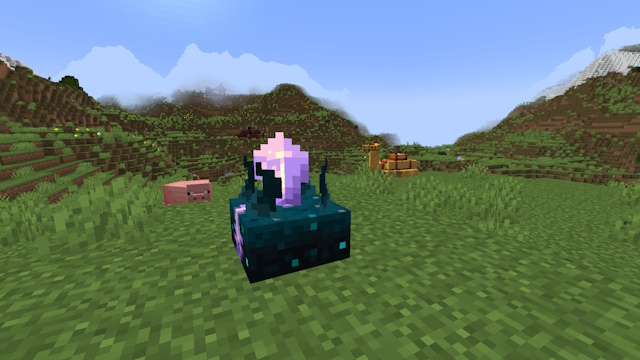
Calibrated Sculk Sensor in Minecraft: General Properties
Similarly to all the sculk blocks, you will need a silk touch enchantment on your hoe (preferable tool) to obtain the calibrated sculk sensor in Minecraft. Check out the best enchantments you can use in Minecraft via the linked article.
Moreover, it has a range of 16 blocks in which it can detect vibrations and has a cooldown of only one second, compared to two seconds of the regular variant. It is stackable (up to 64), emits light level of one, and you can waterlog it to silence it. Calibrated sensor provides redstone signal on all sides, except the input side.
How to Make a Calibrated Sculk Sensor in Minecraft
Crafting Recipe
As previously mentioned, you cannot find the calibrated sculk sensor in the deep dark biome like the rest of sculk blocks, but you need to craft it. To craft the Calibrated Sculk Sensor, you need to follow the below crafting recipe and use one sculk sensor and three amethyst shards.
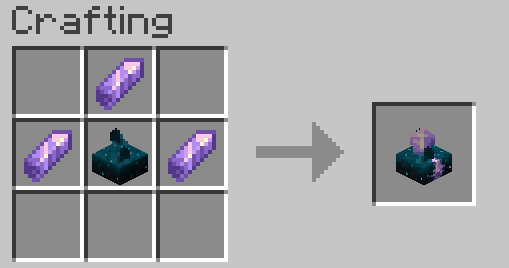
Getting the Resources
Since one of the ingredients for this recipe is a sculk sensor, you will still need to venture into the scary underground biome, so make sure you’re properly equipped. For that, we suggest checking out our dedicated guides on how to make a Netherite sword and Netherite armor in Minecraft. If you perhaps think there’s no need for netherite gear, our guide on Minecraft potions will help you make all the useful potions you could need. Remember to bring a Silk Touch hoe to obtain the sculk sensor blocks.
When it comes to amethyst shards, you will need to locate a geode underground. This usually is not an issue, because you’ll naturally come across it in your world while caving. If you haven’t located it yet, looking underwater first is your best bet. Geodes are spherical generations that can be spotted fairly easily underwater. You can then break the fully grown amethyst clusters with a pickaxe to get the shards. Having Fortune enchantment will provide you with more shards.
Uses of Calibrated Sculk Sensor: What Can You Do With It?
So, we have mentioned that calibrated sculk sensor is an advanced version of the sculk sensor in Minecraft and let’s see exactly why.
1. Filter Frequencies
One of the best quality of life changes related to the calibrated sculk sensor in Minecraft is the fact it automatically filters frequencies. This same feature is available through the regular sculk sensor too. However, previously, players had to “program” the sculk sensor to detect only certain frequencies, and although not difficult, it required more recourses and space.
With the calibrated sculk sensor, it’s far more compact and straightforward. If you don’t program the calibrated sculk sensor, it will behave just like a regular variant. Follow the steps below to set up your calibrated sculk sensor:
- Place a calibrated sculk sensor on the ground.
- Look for a side of this block on which there is an “socket” in the texture. This side is for inputting the redstone signal.

- Adjacent to this side of the block you can place any block that emits a redstone signal and the calibrated sculk sensor will detect only the frequencies that produce that signal. For example, if you place a redstone block attached to the calibrated sculk sensor, only the sounds or frequencies that produce that signal, which is the maximum signal of 15, will be detected. This is completely correct and useful, but we cannot change the redstone signal of the redstone block, it’s always 15.
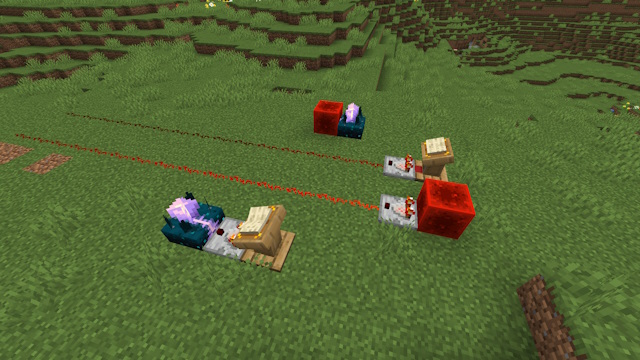
So, if you want to use any other redstone signal to program your calibrated sculk sensor in Minecraft, fear not, because the lectern comes in clutch. We can change the redstone signal emitted from a lectern by changing the page of the book and detect the signal using the Redstone Comparator. To change the redstone signal of the lectern, follow the step-by-step precess:
- Craft a lectern, book and quill and a comparator using the crafting recipes below.

- Right click with a book and quill equipped and write anything on the 15th page. You don’t have to write anything on the pages from one to fifteen.
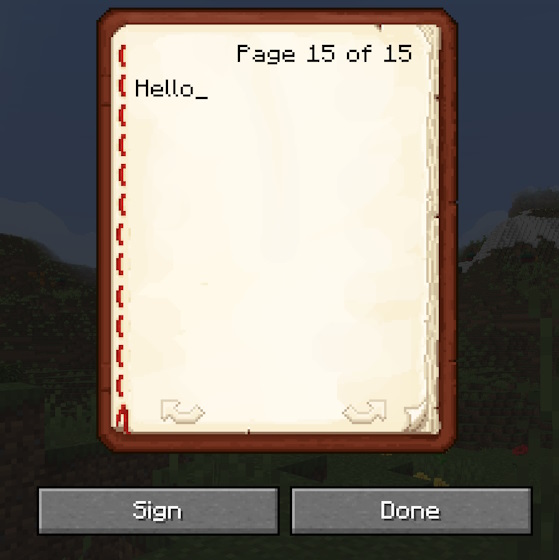
- Place book and quill on the lectern by right clicking on the lectern while the book and quill is selected.
- Place a redstone comparator with a signal input from the lectern.
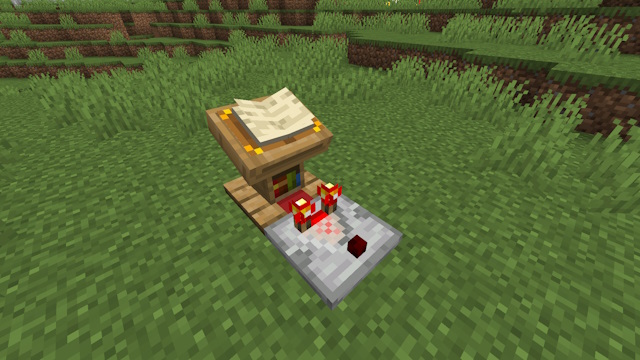
- Change the page of the book by right clicking on the lectern and the comparator will output the signal according to the page selected (from one to fifteen).
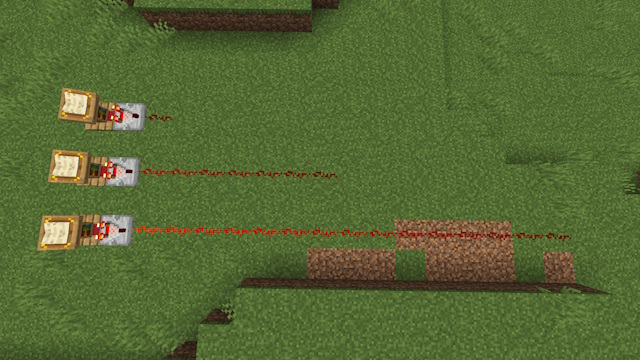
So, with a lectern, you can easily set the redstone signal and the frequencies you want your calibrated sculk sensor to detect in Minecraft. Now, let’s have a look at all the actions and what signals they produce.
Action Redstone Signal Walking/stepping
Swimming
Flapping (e.g. bat flapping its wings)
Resonate 11 Projectile hits something
Entity or an item hitting the ground
Splashing
Resonate 22 Finishing interacting with an item (e.g. reeling a fishing rod)
Projectile fired
Goat horn played
Resonate 33 Ravager roars
Wolf shaking
Gliding with elytra
Resonate 44 Dismounting an entity (e.g. a horse)
Equipping armor
Resonate 55 Mounting an entity
Interacting with and entity (e.g. giving a golden apple to a zombie villager)
Using shears
Resonate 66 Entity taking damage
Resonate 77 Drinking
Eating
Resonate 88 Closing a container (chest)
Door, trapdoor or a fence closes
Lever turning off or button becomes pressable again
Tripwire is detached
Resonate 99 Opening a container
Door, trapdoor or a fence opens
Lever is turned on or a button is pressed
Tripwire is set
Priming a TNT or a creeper ready to explode
Playing a note block
Resonate 1010 Block state changing (grass is converted to farmland or a path)
Resonate 1111 Breaking a block
Bucketing water or lava
Resonate 1212 Placing a block
Placing fluid
Resonate 1313 Entity is spawned (painting or a spawn egg)
Lightning strike
Teleporting
Resonate 1414 Entity dying
Explosion
Resonate 1515
2. Vibration Resonance
Besides the ability to filter frequencies, the calibrated sculk sensor takes the term “wireless redstone” to the next level in Minecraft. The resonance effect is achieved when you place multiple regular sensors (up to 7 or calibrated sculk sensors up to 14 blocks apart) and placing an amethyst block against them.
After you trigger one sensor, it will transmit the signal to other sensors that have an amethyst block attached. You can then set the first calibrated sensor to detect only the desired frequencies using a lectern and a comparator and when the signal is sent to other sensors, it keeps its value.

You don’t need to program every single calibrated sensor to achieve the resonance effect. However, keep in mind that the other sensors can still detect all the frequencies and if you’re not sure whether it’s going to be a problem, we suggest you program all the sensors. You can set them up to detect the same redstone signal.
Using this game-changing feature, you can create insane redstone machines that have not been seen before and very easily too. So, are you looking forward to playing with these awesome new mechanics? Tell us in the comments below!
Frequently Asked Questions
No, calibrated sculk sensor is a vanilla feature introduced in the Minecraft 1.20 update.



















Man this was so useful for my ancient city base. I lov redstone so much, and the sculk sensors are so fun to use.